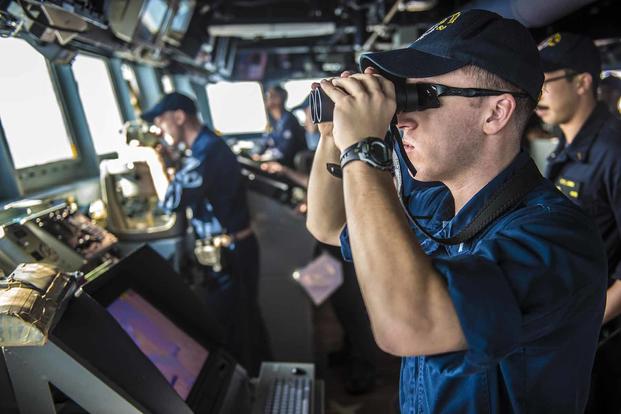The federal government's watchdog agency is recommending that the Navy make significant changes to the Surface Warfare Officer, or SWO, career path.
The Government Accountability Office, or GAO, report, released last week, was commissioned following two at-sea collisions involving Navy ships in 2017 that resulted in the deaths of 17 sailors and hundreds of millions of dollars in damage. Both incidents were blamed in part on failures by SWO watchstanders.
The report found two key issues in the way the Navy currently runs the program: over-commissioning and poor retention.
Read Next: Cash-Strapped National Guard Warns It Will Be Forced to Cancel Training, Ground Aircraft
As an example, the report notes that the destroyer Mustin averaged 18 SWO trainees aboard the ship despite having a requirement for six, and the cruiser Monterey averaged 21 despite needing eight.
Both the report and military retention experts note that overmanning leads to inadequate training and less time to do it.
"That's leading to career frustration, and it's leading to an inability to promote," said Katherine Kuzminski, a senior fellow at the Center for a New American Security.
Problems rising through the ranks then feed the retention challenge, Kuzminski argued.
"If you're looking five years down the line and you think you have no chance of promoting, then why stay?" she said.
One Navy official also noted that SWOs are highly sought after in the civilian sector, which can often place different demands on them than the service.
"When you layer on the amount of time you're spending at sea away from your family, if it feels like it's in service of a promotion, then it may seem worth it, but I think there's a certain existential crisis that happens if you don't see a path forward for yourself," Kuzminski said.
The GAO report notes that only 33% of SWOs stayed in the community after 10 years, compared with 45% of other Navy officers. Among just SWOs, only 12% of female officers stayed beyond the 10-year mark, compared with 39% of their male counterparts.
These figures come after the Navy has already implemented changes to address training shortfalls in the community, including allowing only those in line for command to pursue SWO qualification and requiring officers to keep logbooks of their bridge hours. However, the report argues that some of these changes have yet to yield results.
"We found that the U.S. Navy has not yet analyzed relevant logbook data for trends between the number of SWOs aboard ships and competition for limited training opportunities," it states.
Other changes, like not assigning junior SWOs to ships undergoing long maintenance periods or extending sea tours, "may have exacerbated the issue of hindering training opportunities at sea, since they ultimately reduce the number of ships new officers can serve aboard," the report adds.
For its part, the Navy "welcomes the GAO's feedback regarding the training of Surface Warfare Officers," Cmdr. Nicole Schwegman, a U.S. Naval Surface Forces spokesperson, said in a statement.
"Our continuous and iterative evaluation of our training enables our officers to lead the most capable and advanced Surface Fleet in the world," she added.
The GAO argues that the Navy should fundamentally reevaluate the SWO career path, something the branch has not done "for over a century." Specifically, the report suggests that the service model itself after the navies of U.S. allies and allow SWOs to specialize rather than remain generalists their entire careers. This would allow it to better retain some of the "more than 20 percent of new SWOs commissioned [that] are expected to either leave the SWO community for another U.S. Navy community" or split their time between specialties.
This is a model that doesn't exist in any other military branch, Kuzminski noted.
"If you commissioned [as] infantry, you may take a functional area and become a staff officer, but you're not really going to transfer from infantry to armor."
According to a survey within the report, 65% of SWOs believe that "specialized SWO career paths would best prepare them for their duties." Just 16% prefer the current model.
Ultimately, the GAO report made seven recommendations to Navy leaders that include developing retention plans, better analyzing the data it already collects, and reevaluating and making significant changes to the career path of SWOs.
-- Konstantin Toropin can be reached at konstantin.toropin@monster.com.
Related: The Navy Is Making It Tougher to Earn a Surface-Warfare Officer Pin













